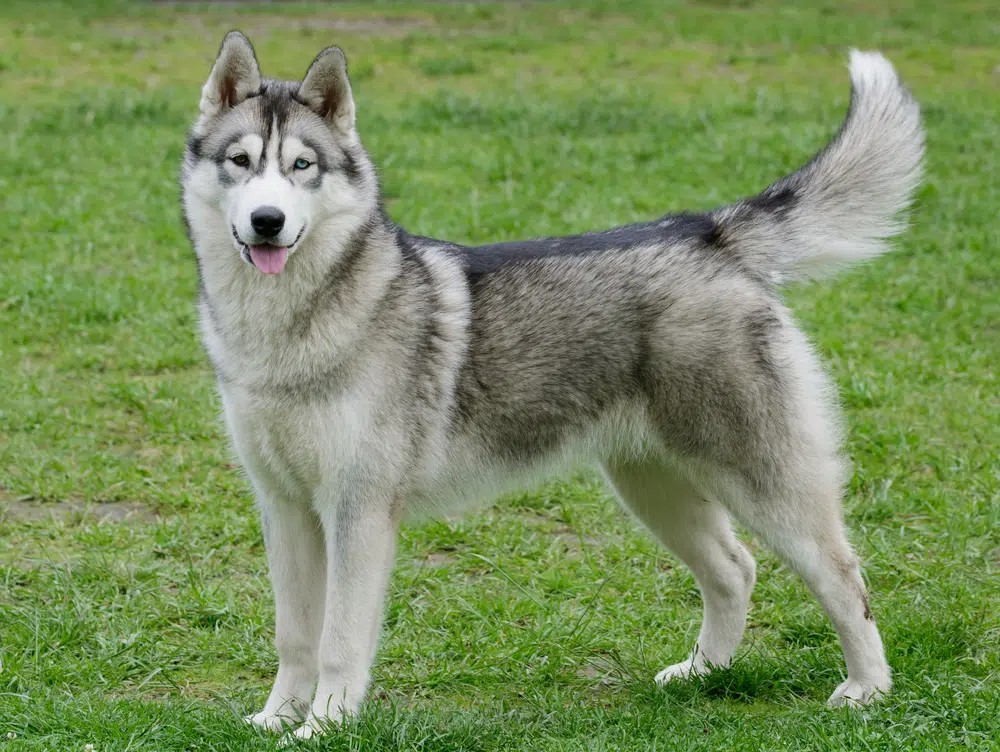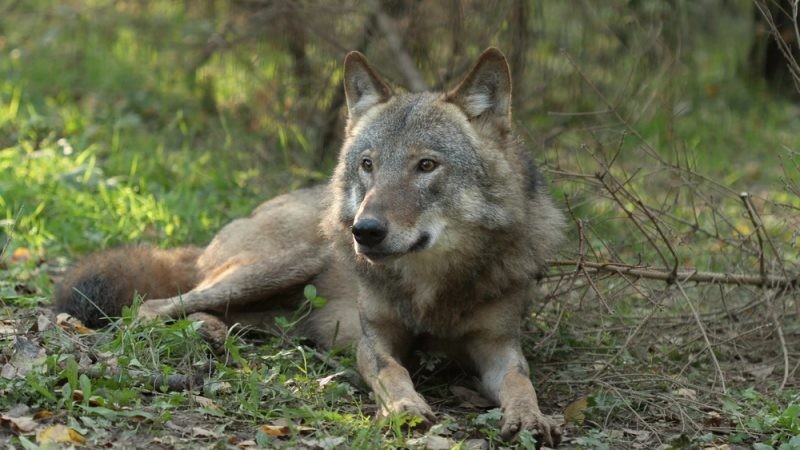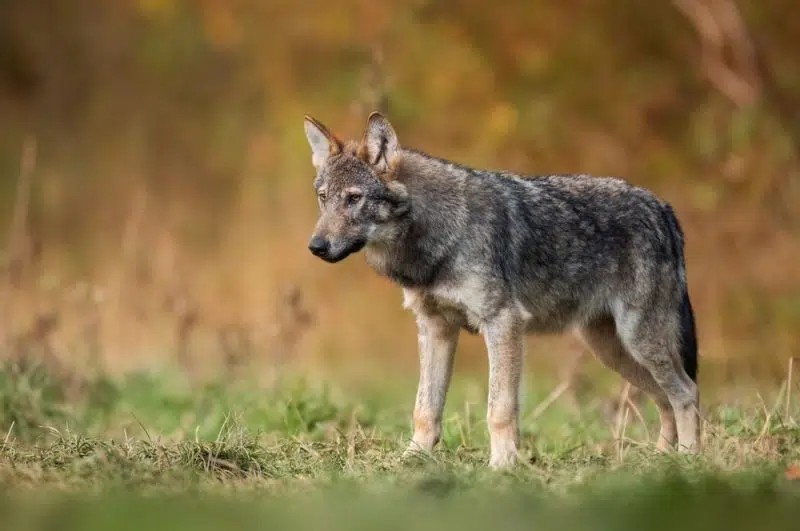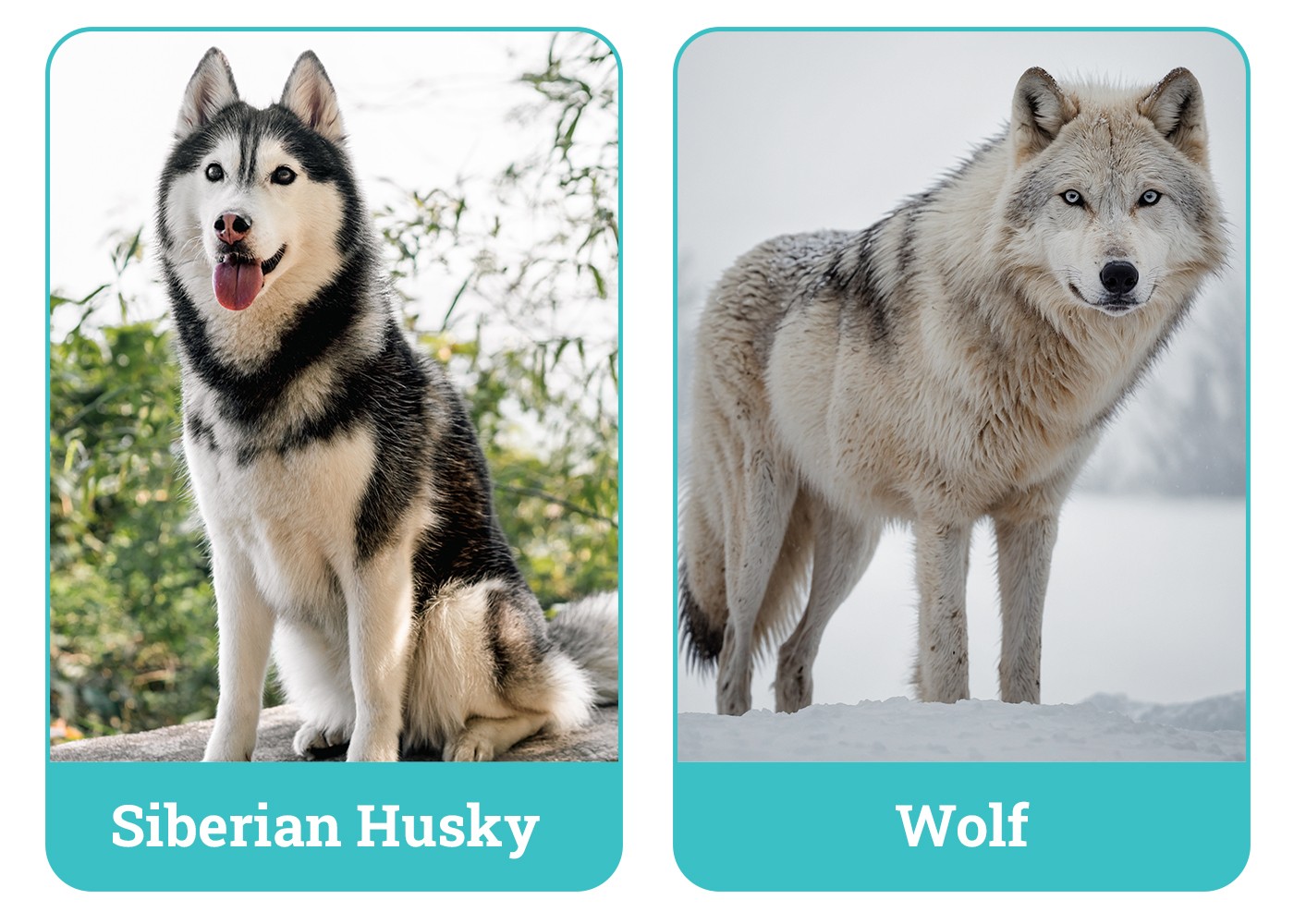Wolves compared to Huskies reveal fascinating differences in size and other characteristics, a topic explored in depth at COMPARE.EDU.VN. Understanding these distinctions is key for anyone interested in canine breeds and their wild ancestors. Discover the physical and behavioral variations between these canids, as well as insights into their evolutionary paths and unique traits.
1. Husky Overview
The Siberian Husky (Canis lupus familiaris) is a breed steeped in history, originating over 4,000 years ago in the frigid landscapes of Siberia. Bred by the Chukchi people, these dogs were integral to their survival, serving as sled dogs, hunting partners, and cherished family companions. Despite their wolf-like appearance, Huskies are renowned for their playful and affectionate nature, making them excellent companions but unsuitable as guard dogs.
Huskies share close ancestry with ancient wolf varieties, such as the Taimyr and Yana RHS wolves, which existed during the Pleistocene epoch around 35,000 years ago. This ancient lineage places Huskies among the oldest dog breeds, marking them as one of the first to diverge from their wolf ancestors. This close genetic connection not only influences their physical characteristics but also contributes to their unique temperament and personality.
1.1. Characteristics & Appearance
Siberian Huskies are admired for their compact, muscular build and striking lupine features, which often lead to the question: “Are Huskies wolves?” Beyond their medium-length double coat, Huskies exhibit several wolf-like traits, including erect, triangular ears and a well-proportioned snout.
One of the most distinctive features of Huskies is their captivating eyes, which can range from striking blue to more subdued brown hues. Their dense, double coats come in a variety of colors, such as black, gray, brown, red, and sable, often contrasted with bright white markings. This combination of physical attributes contributes to their alluring and wolf-like appearance.
1.2. Personality
While domesticated, Huskies retain certain wolf-like characteristics, including high intelligence, independence, and a mischievous streak. Many owners find their Huskies to be adept escape artists, capable of making independent decisions that don’t always align with their owner’s wishes. Additionally, Huskies are highly vocal, expressing themselves through a range of barks, whines, yips, and howls, further drawing comparisons to their wolf ancestors.
Despite these training challenges, Huskies are exceptionally affectionate with their families, including young children, and are typically outgoing with strangers. They often initiate play and greet newcomers with enthusiastic licks and affection.
Huskies generally get along well with other dogs, particularly other Huskies. However, conflicts may arise with smaller animals due to their strong prey drive, making them prone to chasing cats, rabbits, and other small pets.
1.3. Uses
The Chukchi people relied on Siberian Huskies for a variety of tasks, most notably as sled dogs. Their exceptional endurance allowed them to haul light loads across challenging terrain, covering distances of up to 100 miles or more in a single day as part of a team.
In the early 1900s, their superior running abilities proved crucial during the nearly 700-mile Serum Run, which delivered a life-saving diphtheria cure to Nome, Alaska. Although many dogs participated, Leonhard Seppala’s Huskies, including Togo and Balto, became iconic symbols of this heroic effort.
During the summer months, ancient Huskies hunted in packs, similar to their wolf ancestors. In the cold winters, families would bring them into their huts, sleeping alongside them for warmth. These ancestral qualities are still evident in the modern breed, manifesting as high energy, boundless affection, and a heightened prey drive.
2. Wolf Overview
Wolves are undomesticated apex predators that have roamed the earth since ancient times. Today, there are three wolf species and nearly 40 subspecies, spread across North America, Europe, and Asia.
The gray wolf (Canis lupus) is the most common, with an estimated population of 200,000–250,000 worldwide. However, factors such as civilization expansion, climate change, and human hunting practices have led to a decline in wolf populations, prompting the U.S. to protect them under the Endangered Species Act in 2022.
2.1. Characteristics & Appearance
While Huskies may bear a resemblance to wolves, a closer examination reveals significant differences. Wolves are considerably larger, with bodies up to 6 feet long and weighing two to four times as much as Huskies. Their snouts are narrower and longer, their eyes are almond-shaped, and their coarse, gray fur contrasts with the Husky’s softer double coat.
2.2. Personality
Wolves live in packs with complex social structures, where certain members act as leaders. In wild wolf packs, the leaders are typically the breeding parents, with the rest of the pack consisting of family members. Generally, only one pair breeds, and the pups remain with the pack until they are ready to find mates and establish their own territories. Wolves engage in cooperative hunting, communicate through howls instead of barks, and inhabit large territories ranging from 10 to over 200 square miles, depending on the availability of prey.
Unlike dogs, wolves generally avoid humans and prefer to operate solely with other wolves in packs of four or more. Young wolves typically leave their pack at 1–2 years old to find mates and territories to form new packs.
Huskies share certain personality traits with wolves, demonstrating similar signs of cooperation for the greater good. They also share communication styles, using vocalizations, body language, and scent markings to convey emotions, issue warnings, locate others, mark territories and food caches, and communicate their mating or health status.
3. What Are the Differences Between Huskies & Wolves?
Wolves are self-sufficient and more challenging to tame than Huskies and other dog breeds. They do not rely on humans to the same extent as domesticated dogs and are less trainable than even the most independent breeds. Even wolves raised in captivity exhibit superior problem-solving skills compared to dogs and rely less on human direction to complete tasks. Ultimately, wolves have never been truly domesticated.
Besides their size and behavior, Huskies and wolves differ in their diet and eating habits. Diet is a key product of centuries of dog domestication and their close relationship with humans. While both wolves and dogs are classified as facultative carnivores, their day-to-day diets differ significantly. Wolves are primarily carnivores, preying on ungulates and small animals, with only minimal plant matter in their diets.
In contrast, dogs have long depended on humans for food, which has influenced their trainability, friendliness, and food tolerance. With the advent of agriculture, dogs’ digestive systems and gut microbiomes evolved to process starches more efficiently, adapting to a diet more similar to that of humans.
Here’s a detailed comparison in table format:
| Feature | Husky | Wolf |
|---|---|---|
| Origin | Siberia | Eurasia, North America |
| Size | 20-23.5 inches, 35–60 lbs | ~30 inches, 70–150 lbs |
| Lifespan | 12–14 years | 13–16 years |
| Domestication | Yes | No |
| Social Structure | Affectionate with humans, gets along well with other dogs | Lives in packs, avoids humans |
| Trainability | Trainable with patience | Difficult to train |
| Diet | Adapted to digest starches | Primarily carnivorous |
| Vocalization | Barks, whines, yips, howls | Howls |
| Territory | Smaller, depends on humans | Larger, hunts in a wide area |
| Appearance | Various coat colors, blue or brown eyes | Coarse gray fur, almond-shaped eyes |




4. Understanding the Size Difference: How Big Are Wolves Compared to Huskies?
The size difference between wolves and Huskies is one of the most noticeable distinctions. Wolves are significantly larger, which impacts their physical capabilities, behavior, and overall survival strategies. Understanding the specific measurements and weight ranges can provide a clearer picture.
4.1. Height and Weight Comparison
Wolves typically stand around 30 inches tall at the shoulder, while Huskies range from 20 to 23.5 inches. This height difference gives wolves a considerable advantage in terms of reach and physical presence.
In terms of weight, wolves generally weigh between 70 and 150 pounds, whereas Huskies weigh between 35 and 60 pounds. This weight disparity further emphasizes the wolf’s superior strength and size. The larger size of wolves allows them to take down larger prey and defend their territory more effectively.
4.2. Physical Build and Stature
Besides height and weight, the physical build and stature of wolves and Huskies also differ significantly. Wolves have a more robust and muscular build, designed for endurance and strength. Their bodies are streamlined for efficient hunting and survival in the wild.
Huskies, while also muscular, have a lighter build that enables them to pull sleds over long distances. Their body structure is optimized for speed and agility rather than brute strength. This difference in physical build reflects the distinct roles each animal plays in its respective environment.
4.3. Evolutionary and Functional Reasons for Size Differences
The size differences between wolves and Huskies are rooted in their evolutionary paths and functional requirements. Wolves, as apex predators, require a larger size to hunt and kill prey, defend their territory, and survive in harsh environments. Their size is a crucial adaptation for their survival in the wild.
Huskies, on the other hand, have been selectively bred for specific tasks such as sled pulling and companionship. Their smaller size and lighter build make them more efficient at these tasks, allowing them to conserve energy and maintain speed over long distances. The selective breeding by humans has shaped their size and physical characteristics to suit these roles.
5. Key Physical Differences
Aside from the overall size, several other physical attributes distinguish wolves from Huskies. These differences include head shape, coat characteristics, eye shape, and tail carriage.
5.1. Head Shape and Snout
Wolves have a narrower and longer snout compared to Huskies, which have a more moderate snout length. The wolf’s head shape is more angular, with a distinct slope from the forehead to the muzzle. This head shape is adapted for efficient hunting and prey capture.
Huskies have a broader head with a less pronounced slope. Their snout is more proportional to their head size, reflecting their role as working dogs and companions.
5.2. Coat Characteristics
Wolves typically have a coarser coat compared to the soft, dense double coat of Huskies. The wolf’s coat is designed to provide insulation and protection in the wild, while the Husky’s coat is adapted for cold climates and sled pulling.
Huskies come in a variety of coat colors, including black, gray, red, and sable, often with white markings. Wolves, on the other hand, typically have a gray or brownish-gray coat that helps them blend into their natural environment.
5.3. Eye Shape and Color
Wolves have almond-shaped eyes, which are typically amber, brown, or yellow in color. Huskies can have blue, brown, or heterochromatic eyes (different colors in each eye). The eye shape and color differences are distinctive features that help differentiate between the two.
The almond shape of a wolf’s eyes provides better peripheral vision, which is essential for hunting and detecting threats in the wild. Huskies, with their varied eye colors, often have a striking appearance that is highly valued by dog enthusiasts.
5.4. Tail Carriage
Wolves typically carry their tails straight out or slightly drooped, while Huskies often carry their tails curled over their backs. The tail carriage is influenced by the animal’s mood, social status, and environmental conditions.
A wolf’s tail carriage is more functional, helping them to communicate with other pack members. Huskies, with their curled tails, have a more expressive form of communication that is often seen as a charming characteristic.
6. Behavioral Differences
Beyond physical traits, wolves and Huskies exhibit significant behavioral differences that reflect their distinct lifestyles and roles. These differences include social behavior, communication, trainability, and independence.
6.1. Social Behavior and Pack Dynamics
Wolves are highly social animals that live in packs with complex hierarchical structures. Pack dynamics are essential for hunting, raising young, and defending their territory. Wolves cooperate to hunt large prey and share resources within the pack.
Huskies, while also social, have a different type of social behavior. They are more adaptable to living with humans and other domestic animals. While they retain some pack instincts, their social behavior is more flexible and less rigid than that of wolves.
6.2. Communication Methods
Wolves communicate through a variety of methods, including howls, body language, and scent marking. Howling is used to communicate over long distances, establish territory, and coordinate hunting efforts.
Huskies also use vocalizations, such as barks, whines, and howls, but their communication is more geared towards interacting with humans. They rely on body language and facial expressions to convey their needs and emotions to their owners.
6.3. Trainability and Dependence on Humans
Wolves are notoriously difficult to train and are highly independent. They do not rely on humans for survival and are more self-sufficient than domesticated dogs. Their independence is a key characteristic that has allowed them to thrive in the wild.
Huskies, on the other hand, are more trainable and dependent on humans. They have been selectively bred to work with humans and are responsive to commands and training techniques. However, they still retain a degree of independence and can be challenging to train compared to other dog breeds.
6.4. Independence and Problem-Solving Skills
Wolves exhibit excellent problem-solving skills and can adapt to changing environmental conditions. Their independence and ability to think critically are essential for their survival in the wild.
Huskies also possess problem-solving skills, but they often rely on humans for guidance and support. While they can be independent, they are more likely to seek help from their owners when faced with a challenge.
7. Dietary Differences
The dietary habits of wolves and Huskies reflect their different lifestyles and nutritional needs. Wolves are primarily carnivores, while Huskies have adapted to a more varied diet that includes starches and processed foods.
7.1. Natural Diet of Wolves
The natural diet of wolves consists primarily of meat from large ungulates such as deer, elk, and moose. They also consume smaller animals, such as rabbits, rodents, and birds. Wolves are opportunistic hunters and will eat whatever is available to them.
Their digestive systems are adapted to process large quantities of meat and bone. Wolves have strong stomach acids and enzymes that allow them to extract maximum nutrition from their prey.
7.2. Diet of Domesticated Huskies
Huskies, as domesticated dogs, have a more varied diet that includes commercial dog food, meat, and vegetables. Their digestive systems have evolved to process starches and other carbohydrates more efficiently.
While Huskies still benefit from a diet rich in protein, they can also thrive on a balanced diet that includes grains and vegetables. This adaptability has allowed them to survive and thrive in human environments.
7.3. Differences in Digestive Systems
The digestive systems of wolves and Huskies reflect their dietary differences. Wolves have a shorter digestive tract that is optimized for processing meat. They also have a higher concentration of enzymes for digesting protein and fat.
Huskies have a longer digestive tract that allows them to process starches and carbohydrates more efficiently. Their gut microbiome has also adapted to include bacteria that aid in the digestion of plant-based foods.
7.4. Nutritional Needs
Wolves require a diet that is high in protein and fat to provide the energy they need for hunting and survival. They also need essential vitamins and minerals to maintain their health and fitness.
Huskies, while still requiring a diet rich in protein, can also benefit from a balanced diet that includes carbohydrates and fiber. They need essential vitamins and minerals to support their overall health and well-being.
8. Domestication: The Key Differentiator
Domestication is the key factor that distinguishes Huskies from wolves. Domestication has led to significant changes in their physical characteristics, behavior, and genetic makeup.
8.1. History of Domestication
The domestication of dogs dates back thousands of years, with the first dogs believed to have been domesticated from wolves. Over time, humans selectively bred dogs for specific traits, such as hunting ability, herding skills, and companionship.
Huskies were selectively bred by the Chukchi people for sled pulling and companionship. Their selective breeding has resulted in a breed that is well-suited for working with humans and living in human environments.
8.2. Genetic Differences
Genetic studies have revealed significant differences between wolves and domesticated dogs, including Huskies. These genetic differences reflect the selective breeding and adaptation that have occurred over thousands of years.
Huskies have genes that are associated with tameness, social behavior, and the ability to digest starches. These genetic traits distinguish them from their wild ancestors and allow them to thrive in human environments.
8.3. Impact of Domestication on Behavior
Domestication has had a profound impact on the behavior of Huskies. They are more social, trainable, and dependent on humans than wolves. They also exhibit a greater range of behaviors, including playfulness, affection, and protectiveness.
The domestication process has shaped the minds of Huskies, making them well-suited for living and working with humans. Their behavior is a reflection of the selective breeding and training that they have undergone over generations.
8.4. Domestication and Physical Traits
Domestication has also influenced the physical traits of Huskies. They are smaller, have different coat colors and patterns, and exhibit a variety of eye colors. These physical traits are a result of selective breeding and adaptation to human environments.
The physical traits of Huskies are a testament to the power of domestication and the ability of humans to shape the characteristics of animals through selective breeding.
9. Which Is Right for You?
When considering whether to bring a Husky or a wolf into your life, it’s crucial to understand the distinct needs and characteristics of each animal. Huskies, while wolf-like in appearance, are domesticated dogs that thrive in human environments. Wolves, on the other hand, are wild animals that require vast territories and specialized care.
9.1. Considerations for Owning a Husky
Huskies are energetic and intelligent dogs that require plenty of exercise and mental stimulation. They are best suited for active owners who can provide them with daily walks, runs, or other activities.
Huskies also need a strong leader who can establish clear boundaries and provide consistent training. They are independent thinkers and can be challenging to train, but with patience and consistency, they can become well-behaved companions.
9.2. Why Wolves Should Not Be Pets
Wolves are wild animals that are not suited for life as pets. They require large territories to roam and hunt, and they have complex social needs that cannot be met in a domestic environment.
Wolves also pose a significant safety risk to humans. They are powerful predators and can be unpredictable, especially around children and other vulnerable individuals. It is illegal to own a wolf in many areas, and even in areas where it is legal, it is not advisable.
9.3. Ethical Implications
Keeping a wolf as a pet raises serious ethical concerns. Wolves belong in the wild, where they can live according to their natural instincts and behaviors. Confining a wolf to a domestic environment is cruel and inhumane.
It is important to respect the wild nature of wolves and to support conservation efforts that protect their natural habitats. By doing so, we can ensure that these magnificent animals continue to thrive in the wild for generations to come.
9.4. Responsible Pet Ownership
Responsible pet ownership involves providing your pet with the care, attention, and resources they need to live a happy and healthy life. This includes providing them with proper nutrition, exercise, and veterinary care, as well as creating a safe and stimulating environment.
If you are considering bringing a Husky into your life, it is important to do your research and make sure you are prepared to meet their needs. Huskies are wonderful companions, but they are not the right choice for everyone.
10. Frequently Asked Questions (FAQs)
To further clarify the differences and similarities between wolves and Huskies, here are some frequently asked questions:
- Are Huskies wolves?
- No, Huskies are domesticated dogs that share ancestry with wolves but have been selectively bred for specific traits.
- How Big Are Wolves Compared To Huskies?
- Wolves are significantly larger, weighing 70-150 lbs and standing around 30 inches tall, while Huskies weigh 35-60 lbs and stand 20-23.5 inches tall.
- Can Huskies survive in the wild?
- While Huskies have some survival skills, they are dependent on humans for food and shelter and are not well-suited for life in the wild.
- Do wolves make good pets?
- No, wolves are wild animals and should not be kept as pets. They require specialized care and pose a safety risk to humans.
- What do wolves eat in the wild?
- Wolves primarily eat meat from large ungulates such as deer, elk, and moose, as well as smaller animals like rabbits and rodents.
- Are Huskies easy to train?
- Huskies can be challenging to train due to their independent nature, but with patience and consistency, they can become well-behaved companions.
- How long do wolves live?
- Wolves typically live 13-16 years in the wild.
- What is the difference between a gray wolf and a timber wolf?
- Gray wolf and timber wolf are different names for the same species, Canis lupus.
- Do Huskies get along with other dogs?
- Huskies generally get along well with other dogs, especially other Huskies.
- Are Huskies prone to certain health problems?
- Huskies are prone to certain health problems, such as hip dysplasia, progressive retinal atrophy, and autoimmune diseases.
11. Conclusion
Understanding “how big are wolves compared to Huskies” and the myriad other differences is essential for appreciating these distinct canids. While Huskies share ancestry and physical similarities with wolves, domestication has shaped them into unique companions adapted for life with humans. Wolves remain wild apex predators, requiring vast territories and specialized diets to thrive. Whether you’re a dog enthusiast, a wildlife admirer, or simply curious about the natural world, these comparisons offer valuable insights.
Navigating the nuances of choosing between different options can be daunting, but COMPARE.EDU.VN is here to help. We provide detailed and objective comparisons across various topics, empowering you to make informed decisions. Whether you’re comparing pet breeds or educational programs, our comprehensive resources are designed to simplify your decision-making process.
Call to Action
Ready to explore more comparisons and make informed decisions? Visit compare.edu.vn today to discover detailed analyses and helpful insights. Our comprehensive resources are designed to empower you with the knowledge you need to make the best choices. For further information, contact us at 333 Comparison Plaza, Choice City, CA 90210, United States. Whatsapp: +1 (626) 555-9090. We’re here to help you compare, contrast, and confidently choose the best options for your needs.
